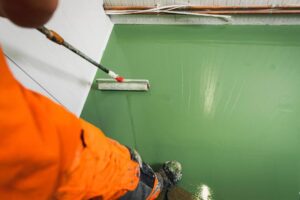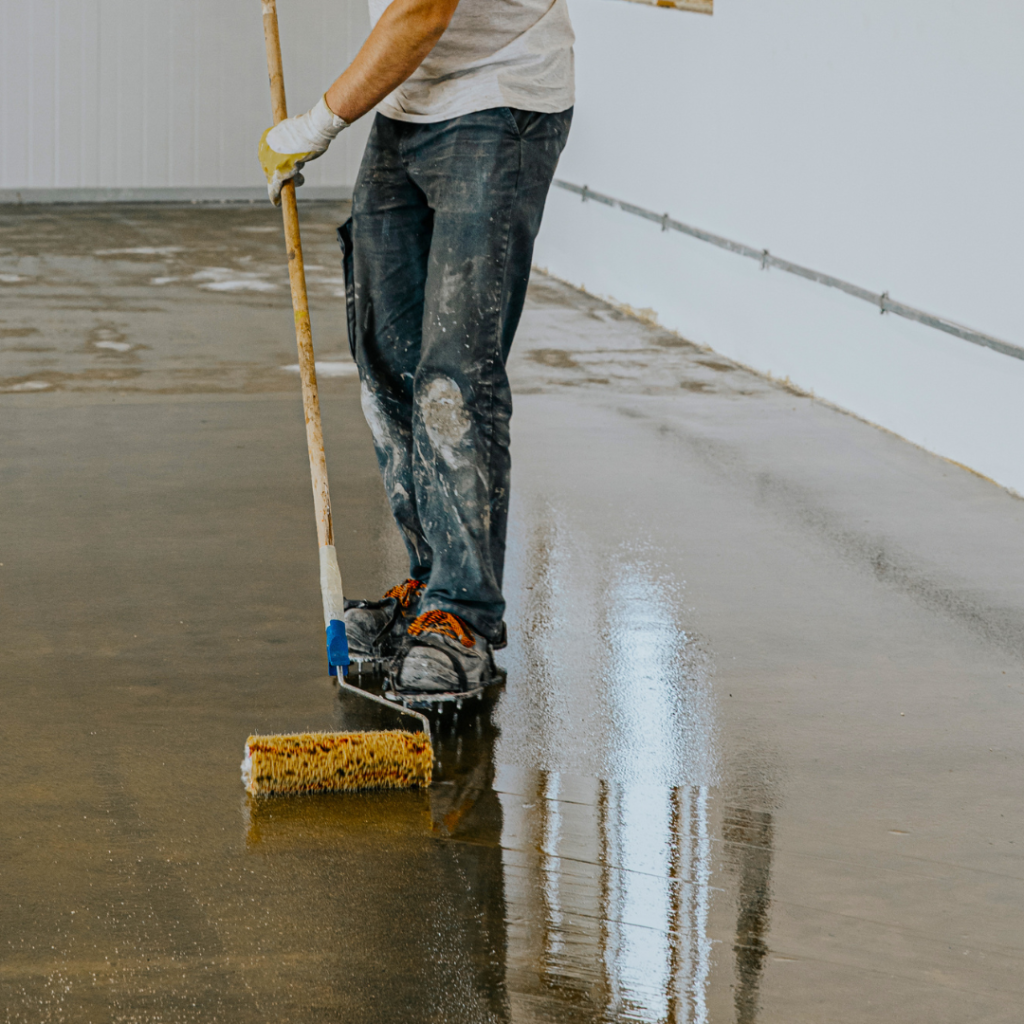
Chemical-Resistant Epoxy Flooring: How It Protects Your Garage Floors
Transform your home with a durable epoxy resin garage floor in just one day. Follow

June 12, 2024

Epoxy floors are popular in commercial, industrial, and residential spaces for their durability and sleek appearance. However, like any surface, it is not immune to wear and tear. Factors such as heavy foot traffic, chemical spills, and inadequate maintenance can diminish its resilience and aesthetic appeal. Recognizing when your epoxy floor may need replacement is crucial to maintaining its functionality and ensuring it continues to protect the underlying concrete floor.
If you’re unsure about the condition of your epoxy flooring, it’s important to stay informed about the potential signs of deterioration. Addressing these issues can prevent more extensive damage and costly repairs for your garage floors, kitchen floors, or even commercial spaces in the future.
Continue reading to discover the seven key indicators that your epoxy floor might need professional attention. Explore expert insights and learn how to keep your flooring in optimal condition for years to come.
Being aware of the initial signs of damage can help in maintaining the entire floor’s integrity and aesthetics. Here are the first signs of epoxy floor damage to look out for:
Monitoring these warning signs not only helps in maintaining the appearance of the floor but also in prolonging its lifespan through timely interventions.
Identifying whether a mark on an epoxy surface is a stain or deep-set damage is crucial for determining the appropriate cleaning or repair method. Here’s a detailed guide to help distinguish between the two:
Identifying whether an issue with an epoxy surface is a stain or deep-set damage primarily involves observing the visual and tactile differences. Stains lie on the surface and can often be cleaned, whereas damage affects the material’s integrity and requires more intensive repair. Regular maintenance and prompt attention to any discoloration or irregularities can help preserve the epoxy’s appearance and functionality.
When dealing with minor cracks in epoxy coatings, the repair process involves a few straightforward steps that can be managed by individuals with basic DIY skills.
First, the area around the crack should be cleaned thoroughly to remove any debris or contaminants. This can be done using a simple combination of soap and water or with a specialized cleaning solution designed for epoxy surfaces. Ensuring the area is clean helps the repair material to adhere properly.
Next, the crack itself needs to be addressed. For very fine cracks, a clear epoxy resin can be applied directly into the crack using a syringe or a small brush. This resin will seep into the crack and, once cured, will form a strong bond that restores the surface’s integrity. It’s important to follow the manufacturer’s instructions regarding mixing and curing times to ensure optimal results.
For slightly larger cracks, it may be necessary to slightly widen the crack first to ensure that the repair material can fully penetrate and fill the damaged area. This can be done using a small grinding tool or a file. After widening, the same process of applying epoxy resin applies.
In all cases, once the epoxy resin has cured, it is advisable to sand the repaired area until it is smooth and flush with the surrounding surface. This not only improves the aesthetic finish but also helps to restore the functional strength of the coating.
Finally, if the repaired area needs to match the color of the existing surface, a topcoat of colored epoxy or paint can be applied once the repair is sanded and cleaned. This step ensures that the repair blends seamlessly with the original surface.
Epoxy floors can peel or delaminate, which compromises both their functionality and aesthetics. Understanding the causes of this issue and how to prevent it can ensure the longevity of epoxy floors.
By addressing these factors, you can enhance the durability and appearance of your epoxy floors. Thus, preventing peeling and ensuring they remain a valuable part of your space for years to come.
To ensure the best possible outcome for your epoxy flooring project, consider enlisting the help of professional epoxy floor contractors. With their expertise, they can properly assess your commercial, residential, industrial, or garage space, recommend high-quality materials, and execute the application with precision.
By choosing experienced professionals such as Apex Flooring, you can avoid common pitfalls such as peeling and enjoy a durable floor for years. Do not hesitate to reach out to a trusted contractor who can provide you with a seamless and successful flooring solution.
Generally, a well-executed repair on an epoxy floor can extend its lifespan significantly. They can often last between 5 to 10 years if maintained properly. The life expectancy of a repaired epoxy floor depends primarily on:
Regular maintenance, such as cleaning spills immediately and avoiding the use of harsh chemicals, is essential to maximize the lifespan of a repaired epoxy floor. Additionally, the floor should be protected from excessive UV exposure and sharp or heavy objects that could damage the surface.
Suggested Reading: Think Twice Before DIY: Shocking Epoxy Bathroom Floor Disasters
When deciding whether to repair or replace an epoxy floor, property owners need to consider several factors to ensure they make a cost-effective and trusted choice. Here’s a detailed guide on how to make this decision:
The first step is to closely inspect the condition of the epoxy floor. Look for signs of wear such as scratches, peeling, discoloration, and cracks. Minor surface issues, like small scratches or slight discoloration, can often be repaired without needing a full replacement.
The age of the epoxy floor plays a crucial role in the decision-making process. Epoxy floors last between 10 to 20 years, depending on the level of traffic and maintenance. If your floor is nearing the end of this lifespan, replacement might be more cost-effective than ongoing repairs.
Compare the costs of repairing versus replacing the epoxy flooring. Small, localized repairs are usually more affordable but might not be worth it if the floor is extensively damaged. Request quotes from professionals for both options and consider if the long-term benefits of epoxy floor replacement outweigh the immediate savings from repairs.
Think about the time it will take for repair or replacement. Repairs can often be completed more quickly than a full replacement, which might require extensive prep work and curing time. The downtime can affect business operations, so choose an option that minimally impacts your daily activities.
Examine if there are underlying issues that caused the damage. Problems like moisture damage or structural faults might require more extensive correction beyond just the surface layer. In such cases, replacing the floor might be necessary to address these deeper issues comprehensively.
Reflect on your long-term goals for the space and the aesthetic outcomes you desire. If the existing floor no longer fits your stylistic preferences or if it’s integral to a larger renovation project, replacing it might offer more satisfaction and value.
For a new epoxy floor installation in Florida, contact Apex Flooring today for a free consultation and free estimates.
If an epoxy floor fails, the responsibility typically falls on the installer or the manufacturer, depending on the issue. If the failure is due to improper installation, such as poor surface preparation or incorrect application, the installer is responsible. However, if the failure is due to defective materials, the manufacturer may be at fault. It is crucial for customers to ensure that both the products and the epoxy floor installation services come with a warranty to cover potential failures.
Epoxy floor coatings can last anywhere from 10 – 20 years with proper maintenance. The lifespan varies based on factors such as the amount of foot traffic, the presence of heavy machinery, exposure to harsh chemicals, and how well the beautiful floor is maintained.
One common defect of epoxy flooring is that it can be slippery when wet. This can be mitigated by adding a non-slip additive to the epoxy during application. Additionally, epoxy floors can sometimes peel or chip if the underlying surface is not properly prepared before application.
Yes, epoxy flooring does wear out over time. The rate at which it wears out depends on the level of traffic and exposure to mechanical wear and harsh chemicals. Signs of wear include dullness, scratches, or peeling. Regular maintenance and reapplication of the top coat can extend the life of an epoxy floor.
The cost of epoxy flooring can vary widely, typically ranging from $3 to $12 per square foot for residential projects, and higher for commercial or industrial spaces which may require more durable materials and complex installation processes. The total cost depends on factors such as the area size, the epoxy type used, the complexity of the design, and the condition of the existing floor. It’s advisable to get quotes from several contractors to compare prices and understand the specific needs of the project.
Written By:
With a bachelors in creative writing and a passion for home design, Laura Gibson connects the dots between design theory and practical flooring solutions. Her expertise is particularly valuable in discussions about how epoxy flooring fits into contemporary interior design trends, providing readers with a blend of practical advice and design inspiration.

Transform your home with a durable epoxy resin garage floor in just one day. Follow

Transform your home with a durable epoxy resin garage floor in just one day. Follow

Discover the most durable garage floor epoxy products reviewed for longevity and protection. Learn expert

Providing epoxy flooring services for homes & businesses in and around Jacksonville, FL
Quick Links
Copyright © 2024 Apex Flooring, LLC, All Rights Reserved.
Act now! Get three premium garage doors installed for just $2700. Boost your home’s curb appeal today.
Don’t miss out on this limited-time offer! Get two premium garage doors installed for only $2300. Transform your home’s curb appeal today.
Ready to upgrade your garage with Apex Epoxy Flooring? Fill out the form below, and let us handle the rest. Whether it’s a 2-car or 3-car garage, we’re here to deliver top-notch service.